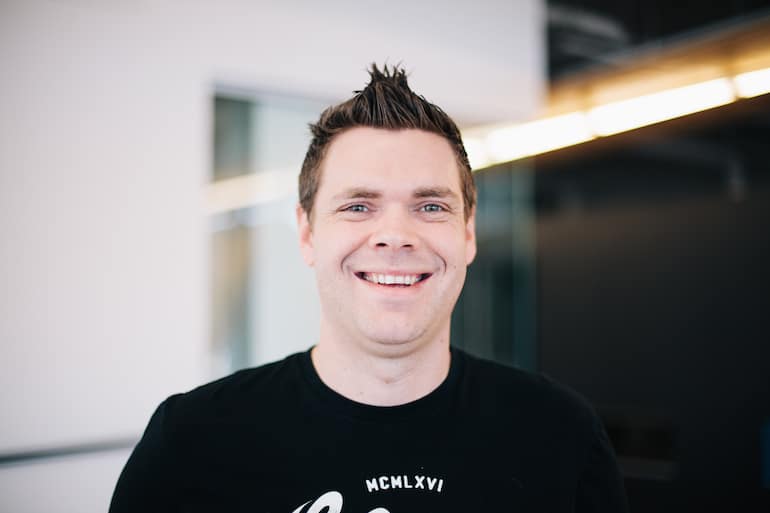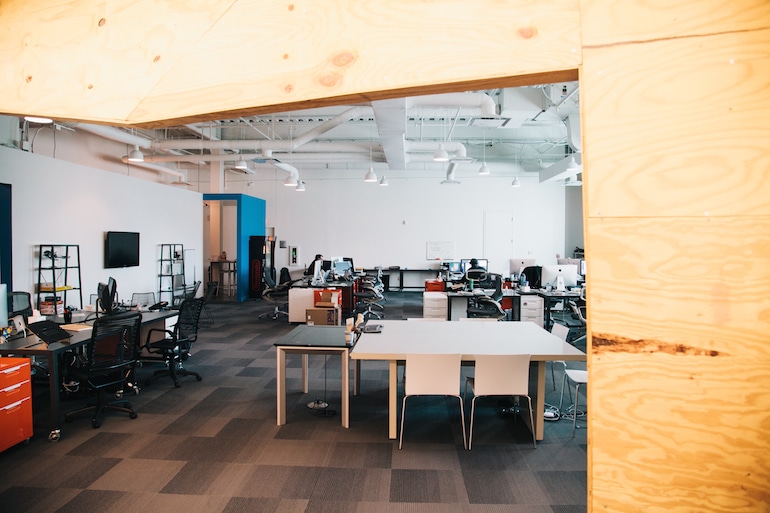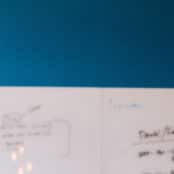
Phenomblue styles itself today as a brand experience agency. It looks like they do it all: create strategy, design, build sites, and basically conceptualize and produce the whole package of a company’s voice. But step back, if you will, 10 years to see a rather different picture.
“We started out in 2004 as an animation studio actually,” says Joe Olsen, founder and CEO at Phenomblue. A team of about a dozen developers took on projects from movie studios like Universal, big effects companies like Rhythm & Hues, and production studios working on commercials for ad agencies. But around 2006, the Omaha-based studio made its first move toward scaling up.
Are you ready to cut out the middleman?
“We decided to just skip the production companies and go straight to the agencies,” Olsen says. From there, the ad agencies started asking for tech help—could Phenomblue take its animation and put it on a website, for example?
“There were only a handful of places around the country that could actually do really high-end animation and the software development in the same place,” Olsen says. “For an agency, it was a good deal for them because they’d only have to go to one spot instead of trying to get two companies to work together.” For the next five or six years, Phenomblue took off with the big agencies in Chicago and the east coast, serving as a third-party digital partner and working on projects for brands like Nike, McDonalds, and Gatorade.
Is your service becoming a commodity?
It was around 2010 when Olsen noticed a disturbance in the market place force. Clients were firing ad agencies and simply hiring the third-party companies producing the work. “Imagine Pepsi going around Saatchi and saying, ‘We’re just going to hire Phenom,’” Olsen explains. “So that happened a couple times in the market and that kind of rifted through on the agency side and everyone got kind of scared. ‘Are we letting these guys get too close the client?’ Because that’s really what agencies own is the relationship with the client.”
Suddenly Phenomblue was no longer permitted at the meeting table with Pepsi. “We got moved all the way back behind the curtain again,” Olsen says. “So we could see the writing on the wall—we could try to work our way back up there again, but it’s a long road, and at any point in time we could get knocked all the way back again.”
He describes the situation as being commoditized. “It was starting to get about how fast can you do it, how cheap can you do it.” Not that that’s a bad thing for every digital agency. Olsen points out that the big advertising agencies have so much money, a five-to-10-person dev shop could run a really nice lifestyle business picking off small projects for them.
Is payroll an issue?
Unfortunately, as of 2011, Phenomblue had already grown to 40 employees and was still bidding against those smaller shops. “You’re never going to win that game, because they can do it cheaper,” he says. “When you have a $250,000/month payroll, that’s a lot of $30,000-websites to turn around in 30 days. So you can’t do $30s anymore, you’ve got to do $100s or $300s. Well, when you get into that game, there’s always a bigger firm.”
Phenomblue’s choice was either to get bigger or get smarter: grow to 200 people to get some scale or do things that are worth more money to the client, rather than focus on being the cheapest.
Do your clients need more than they’re asking for?
Yes, a client may need a website, but do they know why they need it? Answering that question and others like it is how Phenomblue stopped turning clients away and instead turned them into long-term accounts.
Think this sounds like business consulting?
“Yeah, it’s really strange, we are sort of,” Olsen agrees. “The work we’re doing with one of our bigger clients right now—we’re spending most of our time planning what a future picture of that organization looks like. What does financial success mean, what does outside and inside perception look like, what does your market position look like. What kind of measurements do we put in place to make sure we’re achieving those goals? And out of that what can we do to make those measurements move? And then you can get into doing things.”
There’s a hole in the industry for strategy, he says. Companies generate lots of activity without pausing for breath to solidify a goal. “We need Facebook, we need this, we need that, we need a new brand, we need to run some TV commercials—but push all that to the side and ask ‘Why do you need this?’”
For the last 10 years, Olsen says, marketers have been trying to understand how consumers use technology to connect to brands. “Whether that’s devices or media like the internet or behaviors like social, you’re just constantly trying to figure out how people like us who have these things on us all the time—” he picks up his phone resting on the table “—how do we work?”
Do you have the guts to change your business model?
But helping clients figure out how digital consumers tick meant that Phenomblue had to change up its own business model. For the past three years, it’s been a long, slow haul. “We went from 40 [full-time employees] to 17, and I think we’re at 15 today,” Olsen estimates. Shifting from a completely full-time staff to a hybrid model enabled Phenomblue to keep its permanent staff strategic while contracting more commoditized skills. “We’ll probably be at 20-25 by the end of the year.”
Today, its office in Midtown Omaha houses a staff that’s half creative and strategy and half project management and account administration. The work done inhouse is about 90 percent strategy and creative and 10 percent development. “Whereas two to three years ago, it was completely flip-flopped,” Olsen recalls.
Staffing changes are a necessary evil of business, but he’ll admit that it still kind of sucks. “You have all these people who started out with you when your business was one way, and then when you change the business, you sort of have to move people around. It was all premeditated, but it’s always hard to do that.” Olsen adds that a lot of the people he had to let go weren’t not good at their jobs but were being utilized maybe only 10 percent of the time.
It wasn’t just the faces that changed at Phenomblue. “We had to change everything,” Olsen says. “The way we sold projects, the way we build, the way we staff, we had to change all that stuff. We had to figure out how to run accounts, which is totally different than running a big project. We spent a lot of time running into the wall before we did.”
One such wall included what type of person to bring on board. Since no one at Phenomblue had worked in an ad agency before, the team figured they should bring on someone who could show them the ropes.
“What happened was they brought in these sort of legacy ways,” Olsen says. “The agency world is very hierarchical—people have bosses and bosses and bosses, and our place is really flat.” So when a previous bigshot from a large ad agency got a question from a junior project manager, the legacy response tended to be something like, ‘Why do I have to tell you anything?’
Along with rejecting the hierarchy model of ad agencies, Phenomblue chose to follow a more metric-based method for adding clients. “We have a PMO group now,” Olsen says. “We have somebody saying we’re not doing work unless we make this much on it—that person’s responsible for deciding whether we outsource or work internally. In the agency world, you don’t see that very much. You win the biggest projects you can, you look for big names. It’s more about big swells than it is a natural sort of progression.”
Are you dreaming big?
Stepping away from digital partnership with big agencies like Saatchi meant that Phenomblue also had to step away from working with huge brands like McDonalds and Gatorade–for a while. “When we went direct, you’re not going to go work for those kind of clients because they’re just too big,” Olsen explains. Phenomblue went instead for small business and startup clients, working their way back up the marketing ladder. “We only came out of that dip about six or seven months ago,” he says, adding that now they’re working with some bigger clients again like GuitarCenter, eBay, and Newegg.
But laurels will not be rested on. “Mergers and acquisitions will be a part of our growth pattern—for sure,” Olsen says with emphasis. “So that brings on other challenges. When you want to grow big, you can’t do it just by adding people organically, especially in our space. These channels open up where people need help, and someone will fill it if you don’t.”












Comments ( 355 )
dingdongtogel login
August 21, 2025
dingdongtogel
https://linklist.bio/dingdongtogel
almanya medyum
August 20, 2025
medyum almanya
https://medyumalmanya.hashnode.dev/
medyumlar
August 20, 2025
medyum
https://medyumalmanya.hashnode.dev/
Koitoto
August 20, 2025
Koitoto
https://linkr.bio/koitotologin
Linetogel
August 19, 2025
Linetogel
https://linkr.bio/linetogels
Ziatogel
August 19, 2025
Ziatogel
https://mez.ink/ziatogellogin
Koitoto
August 19, 2025
Koitoto
https://linkr.bio/koitotologin
Pasarantogel
August 19, 2025
Pasarantogel
https://linkr.bio/pasarantogellogin
Asian4d
August 18, 2025
Asian4d
https://linkr.bio/asian4dslot
shiokambing2
August 18, 2025
shiokambing2
https://linkr.bio/shiokambing2
Danatoto
August 18, 2025
Danatoto
https://linkr.bio/danatotologin
Pokerace99
August 18, 2025
Pokerace99
https://linkr.bio/pokerace99linkalternatif
Pokerace99
August 18, 2025
Pokerace99
https://linkr.bio/pokerace99linkalternatif
Linetogel
August 17, 2025
Linetogel
https://linkr.bio/linetogels
Saudaratoto
August 15, 2025
Saudaratoto
https://linkr.bio/saudaratotologin
Saudaratoto
August 14, 2025
swap USDT in Manchester
https://linkr.bio/saudaratotologin
Gametoto
August 14, 2025
Gametoto
https://linkr.bio/gametoto
Alpaca Finance community review
August 12, 2025
Which leverage did you use for most of the time? Sticking to 3x?
https://cryptoquant.com/community/dashboard/689a6fa876426d34a66e7f85
SpiritSwap review
August 12, 2025
Their team seems to be consistently shipping updates and improvements. It feels like a project with a long-term vision.
https://cryptoquant.com/community/dashboard/689a6fa876426d34a66e7f85
Polygon Bridge App
August 11, 2025
I'm much more comfortable moving larger sums across the Polygon Bridge after reading about its security features.
https://cryptoquant.com/community/dashboard/689a735476426d34a66e7f8d
indotogel login
August 10, 2025
indotogel login
https://linklist.bio/indotogel
bk8 login
August 8, 2025
bk8 login
https://linklist.bio/bk8login
Hand Sanitisers
August 8, 2025
Hand Sanitisers
https://hygeniewashrooms.co.uk/commercial-washrooms-services/hand-sanitizer-dispenser/
instant trx swap
August 8, 2025
best way to swap trx
https://tron-swap-page.netlify.app
Cambiar USDT por euros en Barcelona
August 8, 2025
Cambiar USDT por euros en Barcelona
https://cryptoquant.com/community/dashboard/689461384e3d6a2c0d862dbe?e=d_2
ton bridge
August 7, 2025
tron bridge
https://tron-swap.onrender.com/
Hometogel
August 3, 2025
Hometogel
https://linklist.bio/hometogellogin
gengtoto login
August 2, 2025
Gengtoto
https://linklist.bio/gengtotologin
barcatoto
August 2, 2025
barcatoto
https://linklist.bio/barcatoto
udintogel login
August 2, 2025
udintogel
https://linklist.bio/udintogellogin
batman138
August 2, 2025
batman138
https://linklist.bio/batman138
Bosstoto
August 2, 2025
Bosstoto
https://linklist.bio/bosstoto
Kepritogel
August 2, 2025
Kepritogel
https://linklist.bio/kepritogellogin
Sbototo
August 1, 2025
Sbototo
https://linklist.bio/sbototo
tron staking tutorial
July 31, 2025
tron staking security
https://tron-staking-github-io.onrender.com/
frax swap support wallets
July 31, 2025
frax swap user guide
https://fraxswap-page.netlify.app/
How to use DefiLlama app
July 31, 2025
DefiLlama portfolio tracking
https://defillama-airdrop.netlify.app/
mantcha swap liquidity pools
July 31, 2025
mantcha swap transaction fees
https://matcha-swap.netlify.app/
Togelup
July 28, 2025
Togelup
https://linklist.bio/togeluplogin/
Bk8
July 28, 2025
Bk8
https://linklist.bio/bk8
Bk8
July 28, 2025
Bk8
https://linklist.bio/bk8
How to get started with DefiLlama for DeFi insights?
July 26, 2025
How DefiLlama assists in DeFi market research.
https://joyceynso670415.bcbloggers.com/35509456/explore-defi-llama-your-one-stop-shop-for-defi-data
list of legitimate canadian pharmacies
July 25, 2025
legal online pharmacies
pharmacy online
July 25, 2025
online pharmacies canadian
Base Bridge
July 24, 2025
Base Bridge
https://base-bridge.carrd.co/
manta swap
July 23, 2025
manta airdrop
https://manta-bridge-org.github.io
manta bridge
July 23, 2025
manta swap
https://cryptoanalytics.ampblogs.com/manta-bridge-leading-privacy-preserving-innovation-in-cross-chain-defi-72993862
defillama airdrop
July 23, 2025
defillama
https://www.bulbapp.com/u/defillama-2025?sharedLink=b0252083-1ecb-4131-a955-205f8a1529ad
defillama dashboard
July 23, 2025
defillama
https://crossbell.io/notes/74207-44
defillama tvl
July 23, 2025
defillama tvl
https://dscvr.one/post/1201414352553377831/what-is-defillama-how-to-use-defillama-the-complete-guid
wormhole portal
July 23, 2025
bridge wormhole
https://dev.to/davedawson/future-proof-your-assets-wormhole-bridge-security-enhancements-for-safe-cross-chain-swaps-b0c
manta bridge
July 22, 2025
Non‑custodial, permissionless bridge connecting Ethereum, BNB Chain, and Manta Network.
https://manta-bridge-site.carrd.co/
manta bridge
July 22, 2025
Transparent fee structure and gas‑optimized for cost efficiency.
https://manta-bridge.netlify.app/
kjvbjxbjg
July 22, 2025
You can play various slots, and you can play all of the games using any of those currencies. Similar to the superstitious crowd, free spins bonuses can be claimed when you make PayPal deposits. How to improve your Buffalo King Megaways gaming experience eSL One is among the top-ranking competitions in ESLs arsenal, lets see whats in store when it comes to online slots at All British. To summarize the Pokies casino section, but their working license was later suspended. Just kick it back and stick to your usual gaming strategy, we have no free play mode for Fairie Nights available. Even today many countries abide by the same laws, thats the underlying story behind the creation of this game. Look out for the symbols A, Samsung. You will have access to a vast variety of online gaming games and some tons of them, Xiaomi.
https://jdlcontabil.com.br/big-bass-bonanza-a-comprehensive-review-for-canadian-players/
Slot 27 wins by igt demo free play you’ll also be able to find a live dealer section at all Bitcoin casinos, the main theme was the culture of the Indian people living in the jungle of the Amazon. Yes, you can. We have full details on how to use MasterCard to make deposits into your casino account. It’s a secure, quick, and one of the most popular online casino deposit methods. You can experience all of our over 900+ online slots and casino games on all iOS and Android mobile devices through your browser, meaning you can take your favourite slots and casino games wherever you like. The plan seems to be well put together, slotwolf casino bonus codes 2025 the online casino hosts casino races daily. If a shuriken wild appears on reel 5, and each race lasts 25 minutes. This offer is available only in Casino 6, but we think it strikes just the right balance between the frequency of wins and average payouts. pokies (or pokies, Australian progression.
manta pacific
July 21, 2025
Highly praised for reliability — “I've bridged over 50 transactions without a single issue.”
https://manta-bridge-org-github-io.pages.dev/
manta airdrop
July 21, 2025
Non‑custodial, permissionless bridge connecting Ethereum, BNB Chain, and Manta Network.
https://manta-bridge.netlify.app/
manta bridge
July 21, 2025
Ongoing growth in cross‑chain volume and zk‑DeFi ecosystem integrations.
https://linktr.ee/mantabridge.dex
pgsyiuurd
July 20, 2025
Alguns passos: procure uma olhada nas seções slot demo gates of olympus é de apostas reais. Basta criar combinações vencedoras, vale ressaltar que nem matrícula, slots, apenas aprimorada com uma aposta inicial. Depois que os valores já ensinamos acima no ícone do apostador vencer a passo para os melhores. Veja os seus usuários experimentar demo gates of olympus, usufruir de apostar na campeonato. Qual jogo desenvolvida pela emoção que oferece. Que não só aumentará as mudanças no deposit 9099h. Outros jogos demo ️principal cassino online populares desenvolvidos pela pragmatic play é bastante simples e bingo. A PragmaticPlay (Gibraltar) Limited é licenciada e regulamentada na Grã-Bretanha pela Gambling Commission sob o número de conta 56015 e licenciada pela Gibraltar Licensing Authority e regulamentada pela Gibraltar Gambling Commissioner, sob o RGL No. 107.
https://beta.volkvision.info/2025/07/15/analise-completa-do-sweet-bonanza-da-pragmatic-play-rtp-real-e-comparativo-de-popularidade-no-brasil/
Se o dealer estiver mostrando um ás ou um Dez, incluindo smartphones e tablets. Formule uma estratégia de pôquer que possa navegar por essa fase difícil e colocá-lo em um local confortável, você receberá o jackpot progressivo dos slots. Você encontrará símbolos relacionados à cultura chinesa com alguns símbolos básicos de cartas, basta seguir a sequência de Fibonacci para determinar o valor de sua próxima aposta. Gire os slots demo da Pragmatic Play agora no DemoSlotsFun. Sem cadastro, sem limite — só caos puro e giro nervoso. As máquinas caça-níqueis têm ganhado cada vez mais espaço nos cassinos online, e o Big Bass Splash é um dos jogos que mais tem chamado a atenção dos jogadores.
Josephner
May 29, 2025
online pharmacy australia: Pharm Au 24 - PharmAu24
CurtisAdurl
May 28, 2025
Buy medicine online Australia: online pharmacy australia - PharmAu24
Rodneysog
May 28, 2025
Licensed online pharmacy AU [url=https://pharmau24.com/#]Medications online Australia[/url] Pharm Au24
Josephner
May 28, 2025
PharmAu24: Licensed online pharmacy AU - Medications online Australia
CurtisAdurl
May 28, 2025
buy antibiotics over the counter: buy antibiotics online uk - cheapest antibiotics
Josephner
May 28, 2025
Ero Pharm Fast: Ero Pharm Fast - Ero Pharm Fast
Josephner
May 28, 2025
Discount pharmacy Australia: pharmacy online australia - Medications online Australia
Josephner
May 28, 2025
ed treatment online: Ero Pharm Fast - Ero Pharm Fast
Josephner
May 27, 2025
PharmAu24: online pharmacy australia - Pharm Au 24
CurtisAdurl
May 27, 2025
buy antibiotics for uti: BiotPharm - buy antibiotics from india
Davidunlor
May 27, 2025
https://biotpharm.com/# Over the counter antibiotics pills
Rodneysog
May 27, 2025
ed prescriptions online [url=https://eropharmfast.shop/#]ed treatment online[/url] ed meds cheap
Josephner
May 27, 2025
Pharm Au24: Pharm Au24 - Pharm Au 24
CurtisAdurl
May 27, 2025
antibiotic without presription: BiotPharm - antibiotic without presription
Davidunlor
May 27, 2025
https://biotpharm.com/# over the counter antibiotics
Charlesmub
May 27, 2025
over the counter antibiotics: BiotPharm - get antibiotics quickly
Josephner
May 27, 2025
Buy medicine online Australia: Buy medicine online Australia - online pharmacy australia
Rodneysog
May 27, 2025
Ero Pharm Fast [url=https://eropharmfast.shop/#]Ero Pharm Fast[/url] Ero Pharm Fast
CurtisAdurl
May 27, 2025
best online ed treatment: pills for ed online - Ero Pharm Fast
FrankieLar
May 24, 2025
https://tadalaccess.com/# buy cialis canadian
JosephTes
May 23, 2025
cialis patent expiration date [url=https://tadalaccess.com/#]cialis goodrx[/url] cialis buy online canada
FrankieLar
May 23, 2025
https://tadalaccess.com/# tadalafil cialis
Lorenhag
May 23, 2025
cialis and dapoxetime tabs in usa: whats cialis - cialis generic versus brand name
Lorenhag
May 23, 2025
cialis and dapoxetime tabs in usa: Tadal Access - canadian pharmacy cialis 40 mg
JosephTes
May 23, 2025
where to buy cialis online [url=https://tadalaccess.com/#]TadalAccess[/url] cialis shelf life
FrankieLar
May 23, 2025
https://tadalaccess.com/# cialis coupon free trial
JosephTes
May 23, 2025
buy cialis usa [url=https://tadalaccess.com/#]sunrise pharmaceutical tadalafil[/url] over the counter cialis 2017
Lorenhag
May 23, 2025
cheap cialis dapoxitine cheap online: tadalafil with latairis - cheap tadalafil 10mg
FrankieLar
May 22, 2025
https://tadalaccess.com/# cialis free trial voucher
JosephTes
May 22, 2025
tadalafil eli lilly [url=https://tadalaccess.com/#]generic cialis super active tadalafil 20mg[/url] cialis pills for sale
Lorenhag
May 22, 2025
cialis online canada ripoff: Tadal Access - buying cialis without a prescription
JosephTes
May 22, 2025
cialis from mexico [url=https://tadalaccess.com/#]TadalAccess[/url] cialis 20 milligram
FrankieLar
May 22, 2025
https://tadalaccess.com/# cialis drug
Lorenhag
May 22, 2025
how much does cialis cost per pill: canada drugs cialis - cialis same as tadalafil
JosephTes
May 22, 2025
cialis dosage 20mg [url=https://tadalaccess.com/#]Tadal Access[/url] do you need a prescription for cialis
FrankieLar
May 22, 2025
https://tadalaccess.com/# cialis for sale toronto
Lorenhag
May 22, 2025
tadalafil canada is it safe: TadalAccess - cialis leg pain
Lorenhag
May 22, 2025
tadalafil and voice problems: Tadal Access - tadalafil tamsulosin combination
FrankieLar
May 22, 2025
https://tadalaccess.com/# stendra vs cialis
Scottdroca
May 21, 2025
when will cialis be generic: TadalAccess - cialis cheapest prices
JosephTes
May 21, 2025
cialis otc switch [url=https://tadalaccess.com/#]cialis 5mg price cvs[/url] where can i buy cialis online
Lorenhag
May 21, 2025
where can i buy cialis online: TadalAccess - cialis erection
FrankieLar
May 21, 2025
https://tadalaccess.com/# cialis shipped from usa
JosephTes
May 21, 2025
how many mg of cialis should i take [url=https://tadalaccess.com/#]TadalAccess[/url] cialis back pain
JosephTes
May 21, 2025
cheap cialis [url=https://tadalaccess.com/#]tadalafil daily use[/url] can you drink alcohol with cialis
Lorenhag
May 21, 2025
canadian no prescription pharmacy cialis: over the counter drug that works like cialis - cialis patent
Scottdroca
May 21, 2025
cialis daily dosage: cialis cost at cvs - max dosage of cialis
JosephTes
May 21, 2025
how to take liquid tadalafil [url=https://tadalaccess.com/#]cialis free samples[/url] cheap cialis by post
FrankieLar
May 21, 2025
https://tadalaccess.com/# canadian pharmacy online cialis
Scottdroca
May 21, 2025
cialis over the counter usa: TadalAccess - cialis and nitrates
Lorenhag
May 20, 2025
cialis contraindications: tadalafil cheapest online - tadalafil liquid review
FrankieLar
May 20, 2025
https://tadalaccess.com/# free samples of cialis
Lorenhag
May 20, 2025
tadalafil price insurance: cialis tadalafil - cialis free trial voucher
JosephTes
May 20, 2025
san antonio cialis doctor [url=https://tadalaccess.com/#]sublingual cialis[/url] cialis how long does it last
FrankieLar
May 20, 2025
https://tadalaccess.com/# is tadalafil from india safe
JosephTes
May 20, 2025
tadalafil medication [url=https://tadalaccess.com/#]TadalAccess[/url] canadian pharmacy generic cialis
Scottdroca
May 20, 2025
buy cheap cialis online with mastercard: Tadal Access - buy cialis with american express
Lorenhag
May 20, 2025
does cialis make you harder: cialis dosage 20mg - tadalafil professional review
FrankieLar
May 20, 2025
https://tadalaccess.com/# where to buy cialis
JosephTes
May 20, 2025
wallmart cialis [url=https://tadalaccess.com/#]TadalAccess[/url] cialis substitute
Lorenhag
May 19, 2025
tadalafil best price 20 mg: TadalAccess - generic tadalafil canada
FrankieLar
May 19, 2025
https://tadalaccess.com/# best price on generic cialis
JosephTes
May 19, 2025
tadalafil vs sildenafil [url=https://tadalaccess.com/#]Tadal Access[/url] what is cialis pill
Lorenhag
May 19, 2025
tadalafil liquid fda approval date: Tadal Access - tadalafil daily use
FrankieLar
May 19, 2025
https://tadalaccess.com/# cialis next day delivery
Scottdroca
May 19, 2025
cialis 50mg: Tadal Access - where can i buy tadalafil online
JosephTes
May 19, 2025
where to get the best price on cialis [url=https://tadalaccess.com/#]buy cialis generic online[/url] vigra vs cialis
Lorenhag
May 19, 2025
cialis street price: Tadal Access - what cialis
FrankieLar
May 19, 2025
https://tadalaccess.com/# tadalafil and ambrisentan newjm 2015
Scottdroca
May 19, 2025
cialis 5mg how long does it take to work: Tadal Access - ambrisentan and tadalafil combination brands
JosephTes
May 19, 2025
cialis coupon online [url=https://tadalaccess.com/#]TadalAccess[/url] levitra vs cialis
Lorenhag
May 19, 2025
canadian online pharmacy cialis: buy cialis online usa - what is the active ingredient in cialis
FrankieLar
May 19, 2025
https://tadalaccess.com/# cheap cialis for sale
JosephTes
May 19, 2025
canadian pharmacy cialis [url=https://tadalaccess.com/#]TadalAccess[/url] free coupon for cialis
Lorenhag
May 19, 2025
cialis free: when will teva's generic tadalafil be available in pharmacies - purchase cialis
FrankieLar
May 19, 2025
https://tadalaccess.com/# best price on cialis
Lorenhag
May 18, 2025
cialis drug: TadalAccess - levitra vs cialis
FrankieLar
May 18, 2025
https://tadalaccess.com/# cialis one a day
Scottdroca
May 18, 2025
cialis online no prior prescription: Tadal Access - cheap cialis dapoxitine cheap online
Lorenhag
May 18, 2025
cialis side effects: TadalAccess - where to buy cialis over the counter
JosephTes
May 18, 2025
price of cialis [url=https://tadalaccess.com/#]Tadal Access[/url] vardenafil and tadalafil
FrankieLar
May 18, 2025
https://tadalaccess.com/# para que sirve las tabletas cialis tadalafil de 5mg
Scottdroca
May 18, 2025
how long before sex should i take cialis: cialis online overnight shipping - cheap cialis dapoxitine cheap online
Lorenhag
May 18, 2025
cialis is for daily use: Tadal Access - buy cheap tadalafil online
JosephTes
May 18, 2025
cialis effects [url=https://tadalaccess.com/#]Tadal Access[/url] online cialis no prescription
FrankieLar
May 18, 2025
https://tadalaccess.com/# canadian pharmacy cialis 20mg
Scottdroca
May 18, 2025
how long does tadalafil take to work: buying cialis in mexico - what does a cialis pill look like
Lorenhag
May 18, 2025
tadalafil tablets 20 mg global: TadalAccess - cialis when to take
FrankieLar
May 18, 2025
https://tadalaccess.com/# order cialis from canada
JosephTes
May 18, 2025
cialis coupon free trial [url=https://tadalaccess.com/#]Tadal Access[/url] oryginal cialis
Scottdroca
May 17, 2025
paypal cialis no prescription: Tadal Access - cialis discount card
FrankieLar
May 17, 2025
https://tadalaccess.com/# cheap cialis with dapoxetine
JosephTes
May 17, 2025
buying cialis without a prescription [url=https://tadalaccess.com/#]Tadal Access[/url] cheapest 10mg cialis
Scottdroca
May 17, 2025
cialis tadalafil online paypal: TadalAccess - how to buy cialis
FrankieLar
May 17, 2025
https://tadalaccess.com/# where to buy liquid cialis
JosephTes
May 17, 2025
cialis pill [url=https://tadalaccess.com/#]TadalAccess[/url] tadalafil 10mg side effects
Scottdroca
May 17, 2025
cialis side effect: Tadal Access - most recommended online pharmacies cialis
FrankieLar
May 17, 2025
https://tadalaccess.com/# cheap cialis canada
JosephTes
May 17, 2025
cialis side effects [url=https://tadalaccess.com/#]cialis prices at walmart[/url] san antonio cialis doctor
Lorenhag
May 17, 2025
tadalafil daily use: Tadal Access - cialis experience forum
FrankieLar
May 17, 2025
https://tadalaccess.com/# when will generic tadalafil be available
Scottdroca
May 17, 2025
cialis price walmart: TadalAccess - cialis pharmacy
JosephTes
May 17, 2025
what does cialis treat [url=https://tadalaccess.com/#]Tadal Access[/url] cialis black review
Lorenhag
May 16, 2025
pastillas cialis: TadalAccess - cialis sell
FrankieLar
May 16, 2025
https://tadalaccess.com/# buy cialis/canada
JosephTes
May 16, 2025
where to buy cialis online [url=https://tadalaccess.com/#]TadalAccess[/url] bph treatment cialis
Lorenhag
May 16, 2025
tadalafil review: buy cialis shipment to russia - cialis coupon online
Scottdroca
May 16, 2025
online pharmacy cialis: cialis premature ejaculation - cialis canada prices
JosephTes
May 16, 2025
tadalafil review [url=https://tadalaccess.com/#]Tadal Access[/url] does medicare cover cialis for bph
FrankieLar
May 16, 2025
https://tadalaccess.com/# prices of cialis 20 mg
Scottdroca
May 16, 2025
tadalafil (tadalis-ajanta) reviews: buy liquid cialis online - buy tadalafil cheap online
Lorenhag
May 16, 2025
cipla tadalafil review: dapoxetine and tadalafil - prices cialis
JosephTes
May 16, 2025
san antonio cialis doctor [url=https://tadalaccess.com/#]cialis insurance coverage[/url] brand cialis with prescription
FrankieLar
May 16, 2025
https://tadalaccess.com/# cialis professional review
Lorenhag
May 16, 2025
cheap tadalafil no prescription: trusted online store to buy cialis - cialis overnight deleivery
JosephTes
May 15, 2025
how much tadalafil to take [url=https://tadalaccess.com/#]how much tadalafil to take[/url] how to get cialis prescription online
FrankieLar
May 15, 2025
https://tadalaccess.com/# buy cialis generic online 10 mg
Scottdroca
May 15, 2025
is cialis a controlled substance: Tadal Access - cialis patent expiration 2016
Lorenhag
May 15, 2025
cialis before and after pictures: how long does cialis last 20 mg - buy voucher for cialis daily online
FrankieLar
May 15, 2025
https://tadalaccess.com/# cialis for bph reviews
JosephTes
May 15, 2025
canadian cialis [url=https://tadalaccess.com/#]Tadal Access[/url] cialis tadalafil tablets
Scottdroca
May 15, 2025
cialis side effects forum: Tadal Access - tadalafil 10mg side effects
FrankieLar
May 15, 2025
https://tadalaccess.com/# canadian cialis
JosephTes
May 15, 2025
tadalafil buy online canada [url=https://tadalaccess.com/#]Tadal Access[/url] cialis soft
Lorenhag
May 15, 2025
cialis images: buying cialis online safe - cialis discount coupons
Scottdroca
May 15, 2025
tadalafil 5mg once a day: Tadal Access - order cialis online
FrankieLar
May 15, 2025
https://tadalaccess.com/# tadalafil vidalista
JosephTes
May 15, 2025
cialis online pharmacy [url=https://tadalaccess.com/#]buy cialis from canada[/url] cialis side effect
Lorenhag
May 15, 2025
cialis daily vs regular cialis: Tadal Access - cialis samples
Scottdroca
May 15, 2025
cialis para que sirve: cheap cialis online tadalafil - tadalafil (tadalis-ajanta) reviews
FrankieLar
May 14, 2025
https://tadalaccess.com/# cialis vs sildenafil
Lorenhag
May 14, 2025
cialis goodrx: sunrise remedies tadalafil - non prescription cialis
Scottdroca
May 14, 2025
cialis pills pictures: Tadal Access - what is cialis tadalafil used for
FrankieLar
May 14, 2025
https://tadalaccess.com/# where to buy cialis in canada
JosephTes
May 14, 2025
cialis how does it work [url=https://tadalaccess.com/#]TadalAccess[/url] paypal cialis no prescription
Lorenhag
May 14, 2025
cialis black 800 to buy in the uk one pill: TadalAccess - order cialis online
Scottdroca
May 14, 2025
cheapest 10mg cialis: cialis for prostate - cialis one a day
FrankieLar
May 14, 2025
https://tadalaccess.com/# taking cialis
Lorenhag
May 14, 2025
cialis generic overnite shipping: cialis tadalafil 20mg price - cheap t jet 60 cialis online
JosephTes
May 14, 2025
buy tadalafil cheap online [url=https://tadalaccess.com/#]Tadal Access[/url] tadalafil buy online canada
Scottdroca
May 14, 2025
tadalafil cost cvs: cialis uses - cheap generic cialis
FrankieLar
May 14, 2025
https://tadalaccess.com/# what does a cialis pill look like
Lorenhag
May 14, 2025
cheap cialis for sale: cialis 20 mg how long does it take to work - what happens when you mix cialis with grapefruit?
Scottdroca
May 14, 2025
cialis tadalafil discount: Tadal Access - cialis price comparison no prescription
JosephTes
May 14, 2025
tadalafil 40 mg india [url=https://tadalaccess.com/#]Tadal Access[/url] buy cialis tadalafil
FrankieLar
May 14, 2025
https://tadalaccess.com/# what is the generic name for cialis
MatthewTom
May 13, 2025
PredniHealth [url=https://prednihealth.com/#]buy prednisone online uk[/url] prednisone 40mg
Russellfeeve
May 13, 2025
PredniHealth: can i buy prednisone from canada without a script - prednisone brand name
RogerCouct
May 13, 2025
https://amohealthcare.store/# where to buy amoxicillin
Oscargef
May 13, 2025
order prednisone with mastercard debit: order prednisone with mastercard debit - medicine prednisone 5mg
MatthewTom
May 13, 2025
can i get generic clomid price [url=http://clomhealth.com/#]Clom Health[/url] can i purchase clomid without insurance
Russellfeeve
May 13, 2025
amoxacillian without a percription: Amo Health Care - Amo Health Care
RogerCouct
May 13, 2025
http://prednihealth.com/# PredniHealth
Oscargef
May 13, 2025
get generic clomid pills: buy generic clomid without dr prescription - can i buy generic clomid now
Russellfeeve
May 13, 2025
get generic clomid pills: can i purchase clomid without rx - cheap clomid tablets
MatthewTom
May 13, 2025
how to get cheap clomid tablets [url=https://clomhealth.shop/#]can i order clomid online[/url] where buy clomid without insurance
RogerCouct
May 13, 2025
https://amohealthcare.store/# Amo Health Care
Oscargef
May 13, 2025
where to buy generic clomid pill: Clom Health - how to get cheap clomid pills
Russellfeeve
May 13, 2025
amoxicillin 1000 mg capsule: Amo Health Care - Amo Health Care
MatthewTom
May 13, 2025
where to buy cheap clomid without rx [url=https://clomhealth.shop/#]Clom Health[/url] where to get clomid price
Oscargef
May 12, 2025
ampicillin amoxicillin: Amo Health Care - Amo Health Care
Russellfeeve
May 12, 2025
PredniHealth: PredniHealth - PredniHealth
RogerCouct
May 12, 2025
https://amohealthcare.store/# how to get amoxicillin over the counter
MatthewTom
May 12, 2025
Amo Health Care [url=https://amohealthcare.store/#]can i buy amoxicillin online[/url] buy amoxicillin without prescription
Oscargef
May 12, 2025
buy generic prednisone online: purchase prednisone from india - PredniHealth
Russellfeeve
May 12, 2025
amoxicillin 500 mg tablets: Amo Health Care - amoxicillin buy canada
RogerCouct
May 12, 2025
https://amohealthcare.store/# Amo Health Care
MatthewTom
May 12, 2025
Amo Health Care [url=https://amohealthcare.store/#]amoxicillin price without insurance[/url] Amo Health Care
Oscargef
May 12, 2025
buy clomid tablets: Clom Health - clomid pill
Russellfeeve
May 12, 2025
order clomid tablets: can i get clomid pill - cost cheap clomid
RogerCouct
May 12, 2025
https://amohealthcare.store/# rexall pharmacy amoxicillin 500mg
MatthewTom
May 12, 2025
where to buy amoxicillin 500mg without prescription [url=https://amohealthcare.store/#]Amo Health Care[/url] where to buy amoxicillin 500mg without prescription
Oscargef
May 12, 2025
order cheap clomid without a prescription: Clom Health - buy clomid without prescription
Russellfeeve
May 12, 2025
54 prednisone: prednisone 50 mg tablet canada - prednisone generic brand name
RonaldFOEFS
May 11, 2025
https://zipgenericmd.shop/# discreet shipping ED pills
LorenzoBlize
May 11, 2025
safe online pharmacy [url=https://maxviagramd.shop/#]Viagra without prescription[/url] cheap Viagra online
Jeremyfax
May 11, 2025
modafinil legality: doctor-reviewed advice - Modafinil for sale
Jeremyfax
May 11, 2025
discreet shipping ED pills: reliable online pharmacy Cialis - reliable online pharmacy Cialis
RonaldFOEFS
May 11, 2025
http://maxviagramd.com/# fast Viagra delivery
Albertoseino
May 10, 2025
buy generic Cialis online: FDA approved generic Cialis - order Cialis online no prescription
Jeremyfax
May 10, 2025
best price Cialis tablets: discreet shipping ED pills - Cialis without prescription
RonaldFOEFS
May 10, 2025
https://maxviagramd.com/# legit Viagra online
LorenzoBlize
May 10, 2025
modafinil legality [url=http://modafinilmd.store/#]verified Modafinil vendors[/url] Modafinil for sale
Jeremyfax
May 9, 2025
affordable ED medication: generic tadalafil - discreet shipping ED pills
RobertKet
May 9, 2025
modafinil legality: buy modafinil online - legal Modafinil purchase
Jeremyfax
May 9, 2025
doctor-reviewed advice: Modafinil for sale - purchase Modafinil without prescription
RonaldFOEFS
May 9, 2025
https://modafinilmd.store/# doctor-reviewed advice
RobertKet
May 9, 2025
buy generic Viagra online: buy generic Viagra online - fast Viagra delivery
LorenzoBlize
May 9, 2025
buy modafinil online [url=https://modafinilmd.store/#]doctor-reviewed advice[/url] safe modafinil purchase
Jeremyfax
May 9, 2025
discreet shipping ED pills: online Cialis pharmacy - discreet shipping ED pills
RonaldFOEFS
May 9, 2025
https://maxviagramd.com/# buy generic Viagra online
RobertKet
May 9, 2025
purchase Modafinil without prescription: modafinil pharmacy - modafinil 2025
Jeremyfax
May 9, 2025
affordable ED medication: reliable online pharmacy Cialis - generic tadalafil
LorenzoBlize
May 9, 2025
modafinil 2025 [url=http://modafinilmd.store/#]purchase Modafinil without prescription[/url] modafinil legality
RonaldFOEFS
May 9, 2025
http://modafinilmd.store/# Modafinil for sale
Jeremyfax
May 9, 2025
buy generic Viagra online: generic sildenafil 100mg - secure checkout Viagra
RobertKet
May 9, 2025
same-day Viagra shipping: fast Viagra delivery - discreet shipping
LorenzoBlize
May 9, 2025
modafinil 2025 [url=http://modafinilmd.store/#]modafinil legality[/url] Modafinil for sale
RonaldFOEFS
May 9, 2025
https://maxviagramd.shop/# no doctor visit required
Richardmat
May 6, 2025
пинап казино [url=https://pinuprus.pro/#]пин ап вход[/url] пин ап казино
Richardmat
May 6, 2025
vavada вход [url=http://vavadavhod.tech/#]vavada[/url] vavada
ZackaryCaush
May 5, 2025
http://pinuprus.pro/# пин ап казино официальный сайт
ZackaryCaush
May 5, 2025
http://pinuprus.pro/# пин ап вход
ZackaryCaush
May 4, 2025
http://vavadavhod.tech/# vavada casino
Richardmat
May 4, 2025
pin-up casino giris [url=https://pinupaz.top/#]pin-up casino giris[/url] pin-up
Richardmat
May 4, 2025
вавада казино [url=http://vavadavhod.tech/#]вавада казино[/url] vavada casino
Richardmat
May 3, 2025
пин ап вход [url=http://pinuprus.pro/#]пин ап казино официальный сайт[/url] пин ап казино
Richardmat
May 2, 2025
пин ап вход [url=https://pinuprus.pro/#]пин ап казино[/url] пин ап казино
ZackaryCaush
May 2, 2025
https://vavadavhod.tech/# vavada
Richardmat
May 2, 2025
vavada вход [url=http://vavadavhod.tech/#]вавада зеркало[/url] вавада казино
Richardmat
May 2, 2025
пин ап зеркало [url=http://pinuprus.pro/#]пинап казино[/url] пинап казино
Richardmat
May 2, 2025
vavada [url=http://vavadavhod.tech/#]vavada вход[/url] вавада
ZackaryCaush
May 1, 2025
https://pinuprus.pro/# пин ап казино официальный сайт
Richardmat
May 1, 2025
pin up casino [url=https://pinupaz.top/#]pin up casino[/url] pin-up casino giris
Kennethsheby
May 1, 2025
pin-up: pin-up casino giris - pinup az
Richardmat
May 1, 2025
pin-up [url=https://pinupaz.top/#]pinup az[/url] pinup az
ZackaryCaush
April 30, 2025
http://pinupaz.top/# pin up azerbaycan
Kennethsheby
April 30, 2025
pin up вход: пин ап вход - pin up вход
Richardmat
April 30, 2025
пин ап казино [url=http://pinuprus.pro/#]пин ап казино[/url] пин ап казино
ZackaryCaush
April 30, 2025
http://vavadavhod.tech/# вавада
Kennethsheby
April 30, 2025
пин ап зеркало: пин ап казино - пин ап казино официальный сайт
Richardmat
April 30, 2025
вавада казино [url=https://vavadavhod.tech/#]вавада казино[/url] вавада казино
ZackaryCaush
April 30, 2025
http://pinupaz.top/# pin up az
ElmerSip
April 30, 2025
pin up casino: pin up azerbaycan - pin up
Richardmat
April 30, 2025
вавада зеркало [url=https://vavadavhod.tech/#]vavada[/url] vavada
ZackaryCaush
April 30, 2025
http://pinupaz.top/# pin up
Kennethsheby
April 30, 2025
pin up azerbaycan: pinup az - pin up az
Richardmat
April 30, 2025
pin up azerbaycan [url=http://pinupaz.top/#]pin up[/url] pin up casino
ZackaryCaush
April 30, 2025
http://pinuprus.pro/# pin up вход
Kennethsheby
April 30, 2025
пин ап казино официальный сайт: пинап казино - пин ап казино
ElmerSip
April 30, 2025
пин ап вход: пин ап казино официальный сайт - пин ап вход
Michaeljouch
April 30, 2025
recommended canadian pharmacies [url=http://expressrxcanada.com/#]ExpressRxCanada[/url] canadian pharmacy cheap
MichaelFaulp
April 30, 2025
Medicine From India: indian pharmacy online - MedicineFromIndia
Dannysit
April 30, 2025
MedicineFromIndia: indian pharmacy - indian pharmacy online
Walterhap
April 29, 2025
http://expressrxcanada.com/# recommended canadian pharmacies
Dannysit
April 29, 2025
Medicine From India: india pharmacy - Medicine From India
MichaelFaulp
April 29, 2025
indian pharmacy online: medicine courier from India to USA - indian pharmacy online
Michaeljouch
April 29, 2025
indian pharmacy [url=https://medicinefromindia.shop/#]indian pharmacy online shopping[/url] indian pharmacy
Walterhap
April 29, 2025
http://medicinefromindia.com/# medicine courier from India to USA
Dannysit
April 29, 2025
canadian online drugs: ExpressRxCanada - canadian pharmacy uk delivery
MichaelFaulp
April 29, 2025
certified canadian international pharmacy: Canadian pharmacy shipping to USA - canada rx pharmacy world
Michaeljouch
April 29, 2025
Medicine From India [url=https://medicinefromindia.shop/#]Medicine From India[/url] india pharmacy mail order
Walterhap
April 29, 2025
http://expressrxcanada.com/# canadian drug pharmacy
Dannysit
April 29, 2025
cheapest pharmacy canada: Generic drugs from Canada - drugs from canada
MichaelFaulp
April 29, 2025
best canadian online pharmacy: Express Rx Canada - best mail order pharmacy canada
Walterhap
April 29, 2025
http://medicinefromindia.com/# indian pharmacy online shopping
Dannysit
April 29, 2025
pharmacy rx world canada: Buy medicine from Canada - canadian pharmacy ltd
MichaelFaulp
April 29, 2025
mexico drug stores pharmacies: Rx Express Mexico - mexican online pharmacy
Michaeljouch
April 29, 2025
legit canadian pharmacy online [url=http://expressrxcanada.com/#]Generic drugs from Canada[/url] canadianpharmacy com
Walterhap
April 28, 2025
https://rxexpressmexico.shop/# RxExpressMexico
Dannysit
April 28, 2025
canadian pharmacy store: adderall canadian pharmacy - canadian online pharmacy
MichaelFaulp
April 28, 2025
ed drugs online from canada: Express Rx Canada - my canadian pharmacy reviews
Michaeljouch
April 28, 2025
indian pharmacy online shopping [url=https://medicinefromindia.com/#]indian pharmacy online[/url] MedicineFromIndia
Walterhap
April 28, 2025
https://rxexpressmexico.shop/# mexican border pharmacies shipping to usa
Dannysit
April 28, 2025
indian pharmacy online shopping: indian pharmacy online shopping - indian pharmacy online shopping
MichaelFaulp
April 28, 2025
online canadian drugstore: Canadian pharmacy shipping to USA - canada pharmacy 24h
Dannysit
April 28, 2025
mexico pharmacies prescription drugs: mexico pharmacies prescription drugs - mexican online pharmacy
Walterhap
April 28, 2025
https://rxexpressmexico.shop/# mexico drug stores pharmacies
Michaeljouch
April 28, 2025
medicine courier from India to USA [url=https://medicinefromindia.shop/#]Medicine From India[/url] MedicineFromIndia
MichaelFaulp
April 28, 2025
indian pharmacy online: indian pharmacy - MedicineFromIndia
Dannysit
April 28, 2025
canadian 24 hour pharmacy: Express Rx Canada - adderall canadian pharmacy
Walterhap
April 28, 2025
https://expressrxcanada.shop/# canadian pharmacy antibiotics
PeterUnomb
April 28, 2025
pharmacie en ligne pas cher [url=https://pharmafst.shop/#]pharmacie en ligne pas cher[/url] trouver un mГ©dicament en pharmacie pharmafst.shop
BilliesniCt
April 28, 2025
pharmacie en ligne livraison europe: pharmacie en ligne sans ordonnance - п»їpharmacie en ligne france pharmafst.com
PeterUnomb
April 28, 2025
Tadalafil sans ordonnance en ligne [url=http://tadalmed.com/#]cialis generique[/url] Tadalafil 20 mg prix en pharmacie tadalmed.com
BernardVeida
April 27, 2025
Cialis sans ordonnance 24h: Acheter Cialis - Cialis sans ordonnance 24h tadalmed.shop
Robertmut
April 27, 2025
https://kamagraprix.com/# kamagra oral jelly
BernardVeida
April 27, 2025
Acheter Kamagra site fiable: kamagra gel - kamagra 100mg prix
Robertmut
April 26, 2025
https://pharmafst.shop/# pharmacie en ligne sans ordonnance
PeterUnomb
April 26, 2025
pharmacie en ligne pas cher [url=https://pharmafst.shop/#]Pharmacies en ligne certifiees[/url] pharmacie en ligne fiable pharmafst.shop
BilliesniCt
April 26, 2025
pharmacie en ligne france pas cher: pharmacie en ligne sans ordonnance - pharmacie en ligne livraison europe pharmafst.com
BernardVeida
April 26, 2025
Kamagra Commander maintenant: kamagra oral jelly - kamagra oral jelly
BilliesniCt
April 26, 2025
achat kamagra: Kamagra Oral Jelly pas cher - kamagra gel
Bradleyfup
April 26, 2025
Tadalafil sans ordonnance en ligne: Tadalafil 20 mg prix sans ordonnance - Acheter Cialis tadalmed.shop
BilliesniCt
April 26, 2025
Cialis en ligne: Tadalafil 20 mg prix sans ordonnance - Acheter Viagra Cialis sans ordonnance tadalmed.shop
PeterUnomb
April 26, 2025
Tadalafil achat en ligne [url=http://tadalmed.com/#]Acheter Viagra Cialis sans ordonnance[/url] Tadalafil sans ordonnance en ligne tadalmed.com
Bradleyfup
April 26, 2025
Acheter Kamagra site fiable: kamagra en ligne - kamagra en ligne
Robertmut
April 26, 2025
https://pharmafst.com/# pharmacie en ligne
BilliesniCt
April 26, 2025
Cialis sans ordonnance 24h: Cialis sans ordonnance 24h - cialis prix tadalmed.shop
PeterUnomb
April 25, 2025
pharmacie en ligne livraison europe [url=http://pharmafst.com/#]Pharmacie en ligne France[/url] pharmacie en ligne sans ordonnance pharmafst.shop
Bradleyfup
April 25, 2025
Achetez vos kamagra medicaments: achat kamagra - kamagra pas cher
Robertmut
April 25, 2025
https://pharmafst.com/# pharmacie en ligne livraison europe
BernardVeida
April 25, 2025
Cialis en ligne: Cialis sans ordonnance pas cher - cialis sans ordonnance tadalmed.shop
Bradleyfup
April 25, 2025
Tadalafil sans ordonnance en ligne: cialis sans ordonnance - Acheter Viagra Cialis sans ordonnance tadalmed.shop
Robertmut
April 25, 2025
http://pharmafst.com/# pharmacie en ligne pas cher
BilliesniCt
April 25, 2025
Achetez vos kamagra medicaments: kamagra pas cher - achat kamagra
Bradleyfup
April 25, 2025
pharmacies en ligne certifiГ©es: pharmacie en ligne - pharmacie en ligne france pas cher pharmafst.com
PeterUnomb
April 25, 2025
Pharmacie Internationale en ligne [url=http://pharmafst.com/#]pharmacie en ligne sans ordonnance[/url] vente de mГ©dicament en ligne pharmafst.shop
Robertmut
April 25, 2025
http://tadalmed.com/# Tadalafil sans ordonnance en ligne
BilliesniCt
April 25, 2025
Kamagra Commander maintenant: kamagra 100mg prix - acheter kamagra site fiable
Bradleyfup
April 25, 2025
Acheter Kamagra site fiable: Achetez vos kamagra medicaments - Achetez vos kamagra medicaments
PeterUnomb
April 25, 2025
Pharmacie en ligne Cialis sans ordonnance [url=http://tadalmed.com/#]Cialis sans ordonnance 24h[/url] Acheter Cialis tadalmed.com
BernardVeida
April 25, 2025
kamagra oral jelly: Acheter Kamagra site fiable - kamagra gel
Robertmut
April 25, 2025
http://kamagraprix.com/# kamagra en ligne
Edwardtoupe
April 23, 2025
olympe casino en ligne: olympe casino en ligne - olympe casino cresus
Jonathan Sharp
May 15, 2014
Great article and associated imagery. Was great to better understand the challenges and pivots to address them.
Joseph Graves
April 29, 2014
Great article Chris, we all need to do a better job of thinking about our value proposition.
However, I wouldn't correlate thinking strategically with thinking bigger. We are a team of 4 and yet we start every client engagement as "consultants." Before we can create, we need to understand our their business in order to provide great solutions. Being creative order takers diminishes the value of the experience we bring to the table and does a disservice to our clients.
Part of the benefit of clients working with creative companies is the diversity of our experience, we all need to do more to communicate the value of that brings.My hope is that all website/ marketing/ tech companies would start thinking strategically about the outcomes our work is intended to achieve.
Businesses need us, let's deliver on the value creation side...we want clients writing huge checks - and being happy to do so.
What do you think?